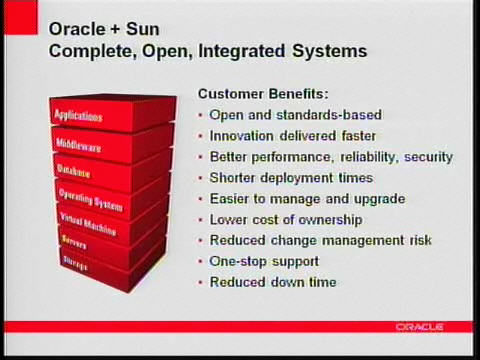Oracle-Sun's great society vision: Will customers bite?

Oracle's new deal for IT buyers looks a lot like the old deal technology executives had in the 1960s: One supplier, service, support and the simplicity that comes with sending the checks to one company. You in?
In the 1960s, IBM was your IT vendor. Now Oracle wants to do the same. Welcome to the land of the IT mega-vendor. There's one throat to choke and lots of integration. It's standardization heaven. The downside: You're dependent on one vendor.
Will IT buyers bite?
Listening to Oracle executives outline their strategy for Sun you'd almost think that T.J. Watson was in the house. Perhaps Larry Ellison was channeling Watson. In any case, amid all the talk about making Sun more efficient and a growth engine the decade of the 1960s kept emerging. To wit:
Oracle president Charles Phillips said:
“We want to recreate that environment of the 1960s, but on open standards.”
Ellison touted the stack of stuff Oracle can sell.
"The proof will be in the pudding in the integrated products we deliver to our customers."
The big question: Do IT buyers want to go back to the 1960s? Oracle honchos portrayed a vision that could be comforting to tech executives. Change management will be easier with Oracle engineers optimizing Sun hardware with its software. Support will be built in and automated. And if you have a big problem there's direct support for the largest customers. In return, Oracle will collect your maintenance and support fees.
Oracle CFO Jeff Epstein held a separate powwow for financial analysts. He outlined the financial nuts and bolts of the Sun strategy. The primary excerpt for IT buyers:
Customer services -- we've talked about how important that is. Renewing and upselling existing hardware support and increasing attach rates -- virtually every customer who buys and Oracle product today buys support. That's not the case with Sun. Some customers are not buying support at all. Some customers are getting support from partners. Some customers may be getting the support. But they're not paying for it. And we have a disciplined approach to all this. And we think that our policies and our value added -- so we'll start with giving really high-quality support, which is essential. But then also through our policies and through our working with our customers who we already have relationships with, we think we can dramatically increase the attach rate and increase the support revenue.
And then the field changes are going to be very significant. So we talked before about having high-margin revenue going direct. So the largest 4,000 customers, we will sell direct to. We will make a higher profit margin on that revenue than we are today through -- that Sun is through partners. And yet we'll still continue these partners for the other tens of thousands of customers.
Epstein's bottom line for Sun is this:
It's the Oracle philosophy, applied to a hardware business.

Sun: 'Bloated and poorly run'
Epstein said Oracle can execute. And why doubt Oracle? The company has integrated dozens of companies. Meanwhile, Oracle's dissection of Sun's supply chain and rampant inefficiencies make you wonder what exactly Scott McNealy and Jonathan Schwartz were doing all day. Perhaps they played on the whiteboard and talked to developers, but operations weren’t much of a focus.Oracle noted that Sun's supply chain would go from build to stock to build to order. Oracle will centralize production and cut the number of suppliers in half. Oracle will also direct ship Sun's hardware and close two distribution centers. In other words, Oracle is doing all the supply chain moves Sun should have completed years ago.
Piper Jaffray analyst Mark Murphy concludes:
We reiterate our belief that Sun was a bloated and poorly run company with strong underlying technology, and that it is ripe for improvement. We think Oracle will prove this rapidly in the first few quarters of combined operations.
What's in it for you?
As Oracle's operations grunt work kicks off, executives will embark on a tour to meet with customers. The pitch: You want integrated systems and Oracle can simplify your life.Murphy bought into Oracle's strategy. He notes:
Oracle can become a one shop for all future products, comprehensive support. Customers will no longer struggle with product configuration and integration across various conflicting vendor technologies, or battle against finger-pointing in the support process. Customers may experience the benefit of faster resolution with fewer vendors to manage while, in our view, Oracle is advantaged by a lower cost structure and greater long-term account control with customers who are truly committed.
Customers may need a little more evidence. Vinnie Mirchandani, who represents buyers in various IT negotiations, highlights a few wrinkles in Oracle's new deal. Mirchandani writes:
So, Mr. and Mrs. CIO, have you enjoyed dealing with your friendly Oracle salesperson over the last few years as you discuss the “value from 22% maintenance”? Are you ready to double your fun conversations with your salesperson to also include hardware?
If so, cheer for the Oracle “Great Society”
But if you want smaller “government”, ask Oracle how it is moving to technology-as-service, where you pay by the drink, not in annual chunks and massive purchase orders. Ask Oracle, where the savings are it promised from the consolidations of the last few years. Ask Oracle what is so illegal about third party support around its products, when it itself happily offers to support Red Hat products and its Sun services support HP and other products.
Customers may not put it as well as Mirchandani just did, but the worry has to be there. What happens when IT is whittled down to just a handful of mega-vendors? Do you really want one throat to choke?